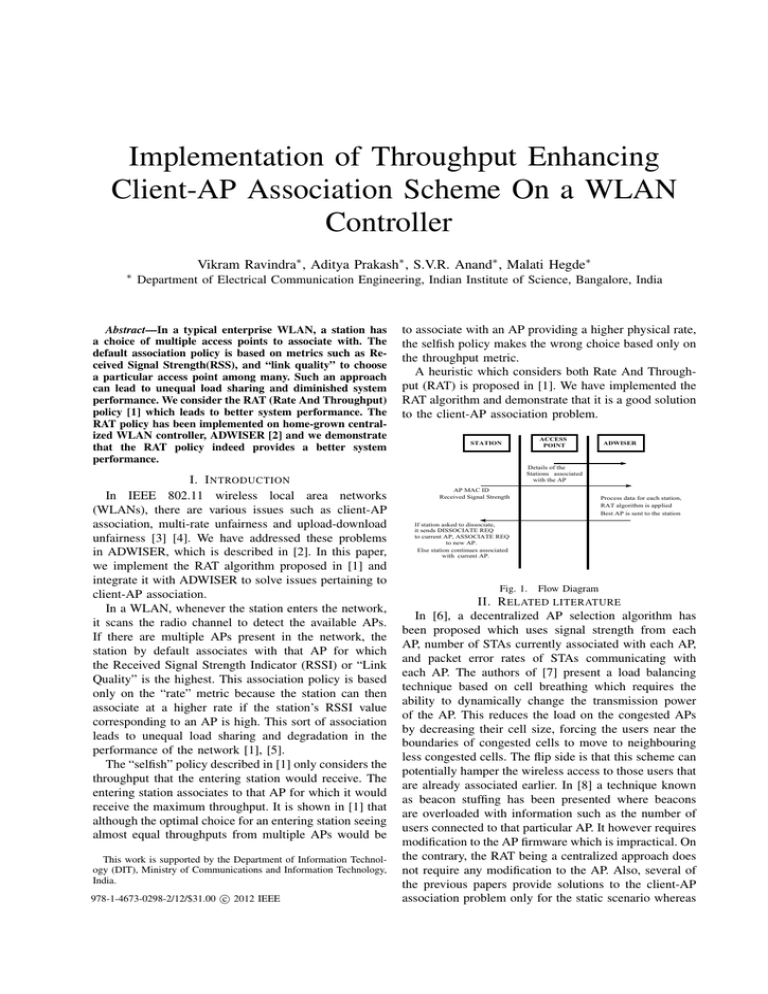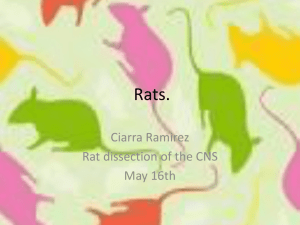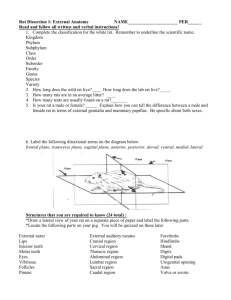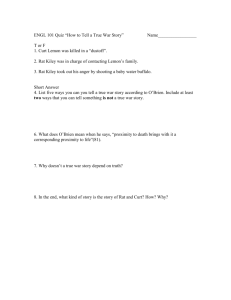Implementation of Throughput Enhancing Client-AP Association Scheme On a WLAN Controller Vikram Ravindra
advertisement

Implementation of Throughput Enhancing Client-AP Association Scheme On a WLAN Controller Vikram Ravindra∗ , Aditya Prakash∗ , S.V.R. Anand∗ , Malati Hegde∗ ∗ Department of Electrical Communication Engineering, Indian Institute of Science, Bangalore, India Abstract—In a typical enterprise WLAN, a station has a choice of multiple access points to associate with. The default association policy is based on metrics such as Received Signal Strength(RSS), and “link quality” to choose a particular access point among many. Such an approach can lead to unequal load sharing and diminished system performance. We consider the RAT (Rate And Throughput) policy [1] which leads to better system performance. The RAT policy has been implemented on home-grown centralized WLAN controller, ADWISER [2] and we demonstrate that the RAT policy indeed provides a better system performance. I. I NTRODUCTION In IEEE 802.11 wireless local area networks (WLANs), there are various issues such as client-AP association, multi-rate unfairness and upload-download unfairness [3] [4]. We have addressed these problems in ADWISER, which is described in [2]. In this paper, we implement the RAT algorithm proposed in [1] and integrate it with ADWISER to solve issues pertaining to client-AP association. In a WLAN, whenever the station enters the network, it scans the radio channel to detect the available APs. If there are multiple APs present in the network, the station by default associates with that AP for which the Received Signal Strength Indicator (RSSI) or “Link Quality” is the highest. This association policy is based only on the “rate” metric because the station can then associate at a higher rate if the station’s RSSI value corresponding to an AP is high. This sort of association leads to unequal load sharing and degradation in the performance of the network [1], [5]. The “selfish” policy described in [1] only considers the throughput that the entering station would receive. The entering station associates to that AP for which it would receive the maximum throughput. It is shown in [1] that although the optimal choice for an entering station seeing almost equal throughputs from multiple APs would be This work is supported by the Department of Information Technology (DIT), Ministry of Communications and Information Technology, India. c 2012 IEEE 978-1-4673-0298-2/12/$31.00 to associate with an AP providing a higher physical rate, the selfish policy makes the wrong choice based only on the throughput metric. A heuristic which considers both Rate And Throughput (RAT) is proposed in [1]. We have implemented the RAT algorithm and demonstrate that it is a good solution to the client-AP association problem. ACCESS POINT STATION ADWISER Details of the Stations associated with the AP AP MAC ID Received Signal Strength Process data for each station, RAT algorithm is applied Best AP is sent to the station If station asked to dissociate, it sends DISSOCIATE REQ to current AP, ASSOCIATE REQ to new AP. Else station continues associated with current AP. Fig. 1. Flow Diagram II. R ELATED LITERATURE In [6], a decentralized AP selection algorithm has been proposed which uses signal strength from each AP, number of STAs currently associated with each AP, and packet error rates of STAs communicating with each AP. The authors of [7] present a load balancing technique based on cell breathing which requires the ability to dynamically change the transmission power of the AP. This reduces the load on the congested APs by decreasing their cell size, forcing the users near the boundaries of congested cells to move to neighbouring less congested cells. The flip side is that this scheme can potentially hamper the wireless access to those users that are already associated earlier. In [8] a technique known as beacon stuffing has been presented where beacons are overloaded with information such as the number of users connected to that particular AP. It however requires modification to the AP firmware which is impractical. On the contrary, the RAT being a centralized approach does not require any modification to the AP. Also, several of the previous papers provide solutions to the client-AP association problem only for the static scenario whereas the RAT considers the dynamic scenario where STAs come and go. III. RAT RAT uses both rate and throughput parameters to calculate the metric that is used to decide the best AP for a station to associate with. The formula used by RAT to calculate the metric is g(i) = αT (i) + βr(i) policy is applied. (ii) The observation of the throughputs after the RAT algorithm is implemented. (1) where α and β are non-negative constants. T (i) is the throughput received by the particular STA from the AP i and r(i) is the rate at which the particular STA is associated with AP i. For each available AP, the station computes g(i) and associates with that AP for which g(i) is the highest. The throughput T (i) is given by [5] as T (i) = 1 Ni1 r1 + Ni2 r2 + ... + (2) NiL rL where Ni1 is the number of stations associated with AP i at a rate r1 , and similarly for Ni2 , . . . , NiL and L denotes the number of possible physical rates. For the default SNR based policy, the values are α = 0 and β = 1. For the selfish policy, the values are α = 1 and β = 0. In our implementation of the RAT algorithm we have considered α = 1 and β = 0.2, as suggested in [1]. IV. I MPLEMENTATION The RAT algorithm has been implemented in ADWISER. The software architecture of the implementation is shown in Figure 1. The newly associated STA will send the scanned results containing the list of APs and the corresponding signal strengths to ADWISER. Based on this information, ADWISER selects the AP with the highest metric as computed in Eq.(1) and is communicated to the STA for re-association. AP1 SWITCH ADWISER SERVER ON LAN STA−2 AP2 STA−1 Fig. 2. Demo Setup V. D EMONSTRATION The demonstration setup is shown in Figure 2. The setup consists of the ADWISER box, two Netgear Access Points, two laptops as stations, a server and a switch. The demonstration will include (i) The observation of the throughputs obtained by the stations when the default Fig. 3. Throuhput vs time VI. R ESULTS We consider two wireless STAs associated at the physical rate of 54 Mbps downloading large files from the server and the throughputs observed by the stations with the default client-AP association are plotted as shown in Figure 3. The individual throughputs obtained by the stations and the aggregate throughput after the RAT policy is applied show considerable improvement. R EFERENCES [1] G. Kasbekar, P. Nuggehalli, and J. Kuri, “Online client-ap association in wlans,” Modeling and Optimization in Mobile, Ad Hoc and Wireless Networks, 2006 4th International Symposium, pp. 1 – 8, april 2006. [2] P. Kumar, K. Vasudev, M. Hegde, S. Anand, A. Kumar, and J. Kuri, “Adwiser: An integrated approach for internet access bandwidth and performance management of an enterprise network,” Communication Systems and Networks (COMSNETS), 2010 Second International Conference, pp. 1 –2, jan. 2010. [3] M. Hegde, S. V. R. Anand, A. Kumar, and J. Kuri, “WLAN manager (WM): a device for performance management of a WLAN,” International Journal of Network Management, vol. 17, pp. 155–170, January 2007. [4] M. Hegde, P. Kumar, K. Vasudev, S. Anand, A. Kumar, and J. Kuri, “Experiences with wm: A centralised scheduling approach for performance management of ieee 802.11 wireless lans,” Communication Systems and Networks and Workshops, 2009. COMSNETS 2009., pp. 1 –10, jan. 2009. [5] G. Kasbekar, J. Kuri, and P. Nuggehalli, “Online association policies in ieee 802.11 wlans,” Modeling and Optimization in Mobile, Ad Hoc and Wireless Networks, 2006 4th International Symposium, pp. 1 – 10, april 2006. [6] Y. Fukuda, T. Abe, and Y. Oie, “Decentralized access point selection architecture for wireless lans,” Wireless Telecommunications Symposium, 2004, pp. 137 – 145, may 2004. [7] Y. Bejerano and S.-J. Han, “Cell breathing techniques for load balancing in wireless lans,” Mobile Computing, IEEE Transactions, vol. 8, pp. 735 –749, june 2009. [8] R. Chandra, J. Padhye, L. Ravindranath, and A. Wolman, “Beaconstuffing: Wi-fi without associations,” Mobile Computing Systems and Applications, 2007., pp. 53 –57, march 2007.







